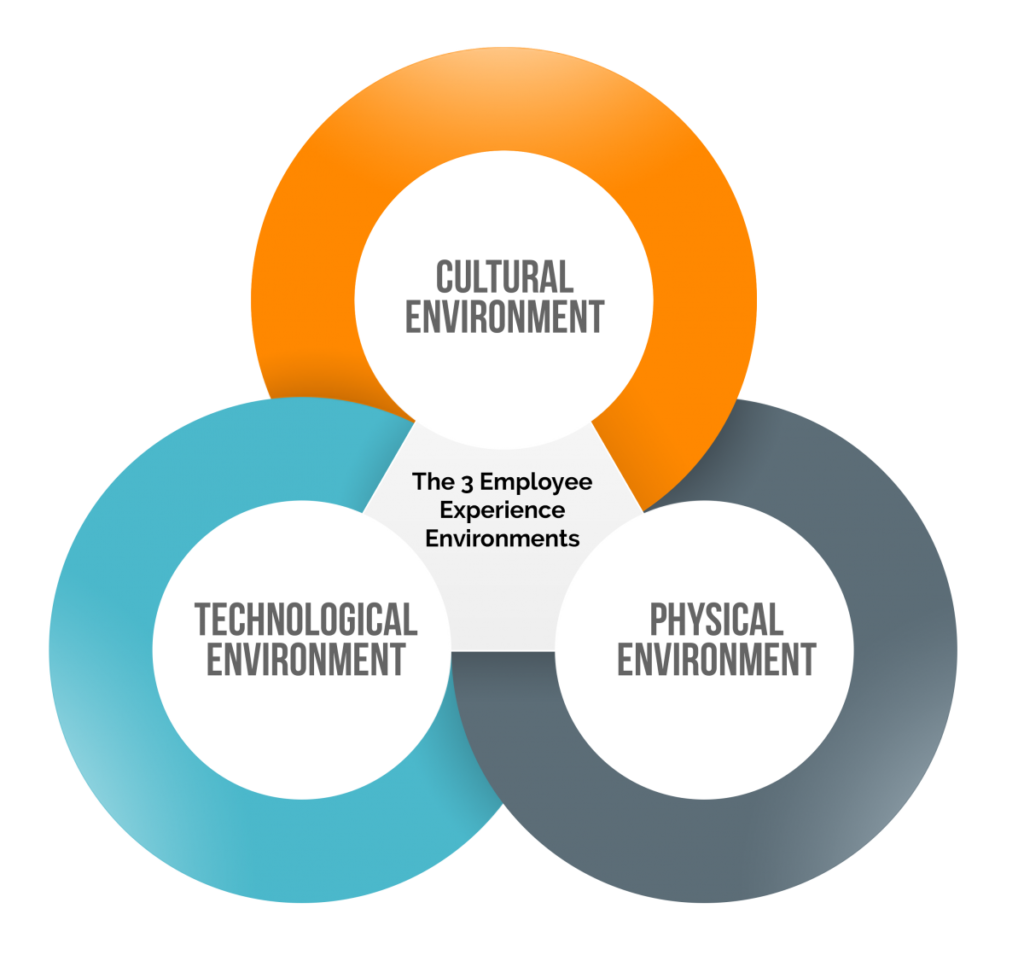I define “employee experience” as an organization creating a place where people want to show up instead of assuming that people need to show up. This shift from “need” to “want” is the fundamental change that organizations around the world are starting to experience. This is why we see so much investment in new offices spaces, health and well-being programs, maternity and paternity leave, healthy foods, workplace flexibility, and so much more. There are a lot of things that can go into creating an employee experience but the good news is that every single company regardless of their industry, geography, or size, only need to focus on three things. Every employee experience is comprised of three environments: the physical environment, the cultural environment, and the technological environment as seen below.
Cultural Environment
We have all heard of corporate culture and the many ways to describe it. Some say “it’s what happens when the manager leaves the room,” others say culture stems from the values, attitudes, practices, and the mission of the organization, and some say culture is controlled by the CEO and the executives. Regardless of what you believe culture is or where it comes from, the one thing that is common is that culture is about feeling. If the physical environment is about the one that you can see, touch, taste, and breathe, then the cultural environment is the one that you feel; it’s the “vibe” you get when you walk in the door and it’s the mood and the tone that the workplace sets. It’s the leadership style, the sense of purpose your employees feel, the organizational structure, and the people that make up your organization. It’s not written and it’s not stated yet it is one of the most important elements of creating and designing the employee experience. Typically corporate culture is what energizes us or drains us, it motivates us or discourages us, it empowers us or it suffocates us. We all experience the corporate culture of our organizations every single day, whether it be positive or negative.
Physical Environment
The physical workspace is the one we can see, touch, and taste, and smell. It’s the art that hangs on the walls, the office floor plan, the demographics of the people we work with (old, young, diversity, etc), and any physical perks we might get such as catered meals in a beautiful cafeteria, an on-site gym, or a lounge area that employees can use to unwind a bit. Before reading on think for a minute about your physical workspace and how it makes you feel. Do you get excited and energized or do you feel as if you are walking into a hospital or doctor’s office?
As a work futurist part of my job is to tour offices at organizations all around the world to see how they are designed and perhaps more importantly why they are designed in certain ways. Many people believe the offices are actually are going to become exciting but I am seeing the exact opposite trend: “The Office Space Isn’t Dead, It’s Making A Comeback.”
Technological Environment
The technological environment of the organization refers to the tools employees use to get their jobs done. This includes everything from the internal social network your company might use to the mobile devices that are approved to the laptops, desktops, and video conferencing solutions that employees have access to. This also includes any apps, software, e-learning tools, and user experience and design elements that impact how employees use these various tools. Technology is the central nervous system of the organization and most concepts and themes related to the future of work are not possible without technology.
It’s not hard to see why technology is such a big part of the employee experience. If you show up to work and are forced to use technologies that were considered “cool” in the 90s then clearly you’re going to be a bit frustrated with getting your job done. Using outdated and poorly designed technologies will: make it harder for your to communicate and collaborate with employees, drastically increase the amount of time it takes you to get your job done, and create an environment that sees you being frustrated, angry, and unproductive instead of being engaged, happy, and productive.
The future of work is all about the employee experience and this is something that organizations around the world are realizing and investing in. What kind of an experience are you creating for your employees and how are you doing it?
Jacob Morgan is a keynote speaker, author, and futurist. You can invite Jacob to keynote your next conference, subscribe to his videos on Youtube, check our his podcast, or subscribe to his newsletter!

